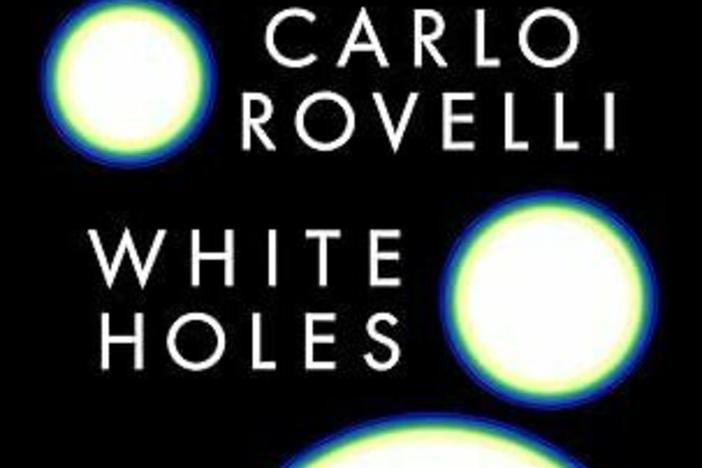Section Branding
Header Content
From Poverty To Stanford, Memoir Tells A Physicist's Remarkable Tale
Primary Content
The stars can save you: If you can really see them in all their beauty and mystery, they can lift you up and give you solace in even the worst times.
That's the potent lesson from A Quantum Life: My Unlikely Journey from the Street to the Stars, the new memoir from astrophysicist Hakeem Oluseyi and writer Joshua Horwitz. Tracking Oluseyi's journey from the streets of Los Angles, Houston and New Orleans to graduate study in physics at Stanford University, A Quantum Life is not only a story about resilience but also about the power of science as a transcendent force for personal transformation.
Hakeem Oluseyi was born as James Plummer Jr. The book opens the night his parents split up (a bright, proud and decidedly urban mother and handsome, capable and "country" father). For the next few years, Oluseyi's mom moves him and his sister to different cities and different Black neighborhoods. As Oluseyi grows older, he simultaneously becomes aware of the inherent racism of the social world around him and his own inherent, interior focus on the natural world. The first section of the book details the challenges he faces in communities that are both rich in relationship and struggling with inequality. At the same time, he faces his own struggle as his mother deals with mental illness and his father takes him into the entirely new universe of rural life in Piney Woods Mississippi.
All through these changes, Oluseyi becomes progressively aware of his own questions about the universe and his strange (to everyone else) capacities as a questioner. As a shy kid trying to steer clear of bullies, he counts things relentlessly and, in his counting, begins to find order and pattern in the world. He begins a life of experimentation, much to his mother's chagrin, pressing burning incense cones into the shower curtain to see how long they take to make a hole. And, on a glorious night out in the country, he catches a glimpse of the dark night sky awash in stars. By his teen years, the fire of inquiry was burning hard in the young man.
A Quantum Life then follows Oluseyi's journey through high school and on to college, where a series of mentors recognize his talent and drive him forward, opening doors that eventually lead to graduate school at Stanford. While elements of this story that have been told before — a bright kid from an underprivileged background makes good in science through talent and grit — there are important aspects of Oluseyi story that demand their own recognition. Oluseyi is not an ultra-nerdy kid who stands apart from the community. Though born with the heart of a nerd, Oluseyi does not live apart from the streets or their greatest dangers. Along his journey Oluseyi picks up a drug habit that haunts him well into his graduate school years. In this way, Oluseyi's story is not that of an otherworldly super-genius whose pure mentality allows him to rise above every challenge, but of a young man with a keen and intense talent in physics who must also deal with the very real world problems of addiction and a young family.
It's the story of Oluseyi's time as a graduate student at Stanford that was most compelling to me. As an astrophysicist who also came from a background of poverty (in industrial New Jersey, making my story more Sopranos than Boys In The Hood), I also remember the potent mix of self-doubt and heady excitement that comes with the first years of graduate training in physics. Oluseyi captures the sense that you're peering into the world's secret core. In a powerful moment, he describes his first glimpse of the sun through a new instrument he'll use in his research. He writes:
"I realized I was now one of a select few humans anywhere on Earth to behold the invisible face of the sun. After tens of thousands of years of squinting up at the bright orb at the center of our solar system and wondering, we could finally see the sun's true nature."
Few people understand what getting a PhD in physics really involves, and at moments like this A Quantum Life offers a clear guide of its rituals, joys and hurdles. But what is also clear from Oluseyi's experience is the racism he had to navigate including during his time at Stanford (something I did not have to face in my career). Time and again there are faculty members in the department who let him know they don't think he belongs there. At its most extreme, this discouragement meant purposely moving the goal posts on the all-important physics "Qualifying Exam," ensuring that Oluseyi "failed" even though he passed by the department's own standards.
But Oluseyi also has mentors who stand firm in their recognition of his talents and capacities. Most important among these is his PhD advisor Art Walker, a Black physicist who pioneered new methods for observing the sun. One of the most satisfying moments in the book is when Oluseyi includes one of the nay-saying professors on his thesis defense committee. This was a bold move because the scientist could have failed him. But instead he publicly acknowledged the value of Oluseyi's work as a researcher.
A Quantum Life is an important book for anyone who wants to understand the institutional hurdles that have kept science mostly white and mostly male. But it's also an important book for anyone who wants to understand how the fire of inquiry, the burning demand to know the world and its beauty intimately, can take root in a heart and lift it up to shine brightly with the stars it most cherishes.
Adam Frank is an astrophysics professor at the University of Rochester and author of Light of the Stars: Alien Worlds and the Fate of the Earth. You can find more from Adam here: @adamfrank4.
Copyright 2021 NPR. To see more, visit https://www.npr.org.
Bottom Content




